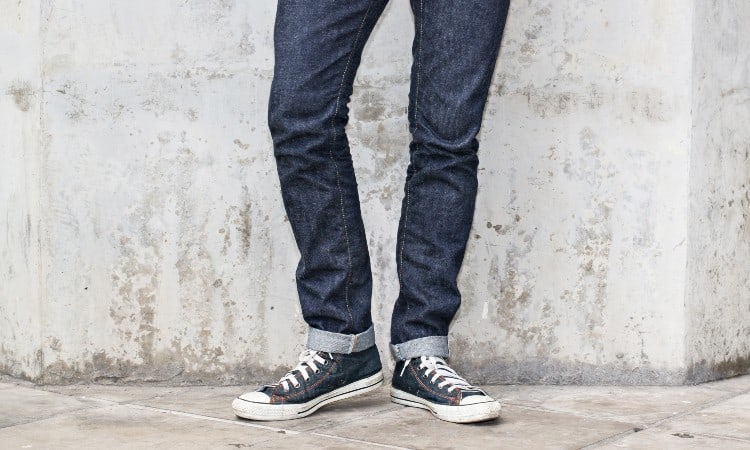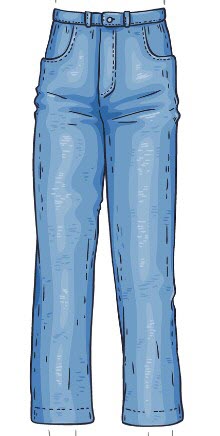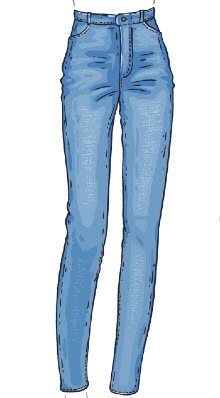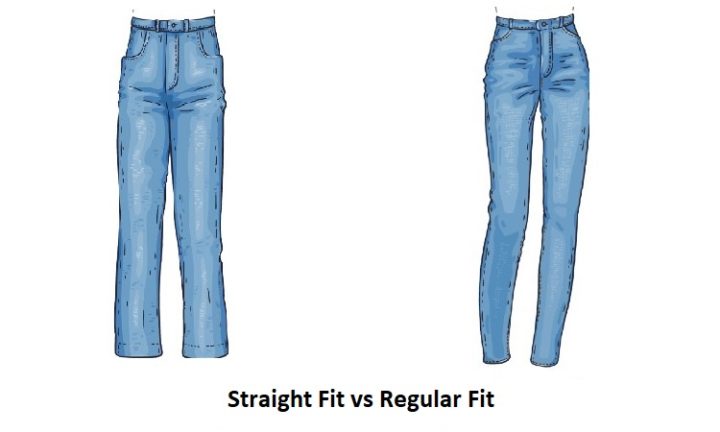When you aren’t making all your clothes to the exact measurements of your body, finding a size and style that flatters you and feels comfortable can be tricky. Plus, the clothing labels usually don’t give you measurements, just loosely descriptive terms like “slim” or “regular” or “straight. It can be hard to know the difference between straight fit vs. regular fit.
The main difference between regular fit clothing and straight fit clothing is how loose the garment fits around your body. These terms usually describe pants. Regular fit pants are more relaxed, but they have some waist shaping, where straight fit pants are slimmer and have no waist shaping.
This guide will give you a nuanced look at how a straight fit and a regular fit are different and how they are similar. Knowing the differences will help you pick the right style for you.

Straight Fit vs. Regular Fit: Key Points
Telling the difference between straight fit and regular fit pants is all about knowing what part of the pants to look at. Both straight fit and regular fit pants have straight legs, meaning the legs don’t taper in or flare out below the knee. However, there is a difference through the hips and seat and the width of the leg.
Regular fit pants sit more loosely on the body than straight fit pants. They taper from the hips to the thigh, but the whole pant leg is the same width. Straight fit pants fit more closely to the body, and the diameter is smaller overall than a regular fit. There is no taper from hips to thigh in a straight fit.
You can break it down like this:
| Pants Fit | Regular | Straight |
| Leg Opening | 16-18 inch diameter | 10-11 inch diameter |
| Cut | Straight | Invariant |
| Rise | mid-rise | Mid- to high-rise |
| Seat | Roomy | Close-fitting, but not snug |
| Body Type | Larger frames, big-boned | Universally flattering |
In short, straight fit pants sit in between regular fit pants and slim fit pants. They work well for most body types, including both apple and pear shapes. Regular fit pants are more comfortable for larger bodies or frames with bigger hips and seats.
What is Straight Fit?
 Whether they are jeans, khakis, or slacks, straight-fit pants are a more tailored look. They sit close to the body without being clingy. While the legs are all one diameter, they usually look wider below the knee than above because human legs are naturally larger in the thigh than the calf.
Whether they are jeans, khakis, or slacks, straight-fit pants are a more tailored look. They sit close to the body without being clingy. While the legs are all one diameter, they usually look wider below the knee than above because human legs are naturally larger in the thigh than the calf.
They are called straight fit because the fabric from the hips to the ankle is cut in a straight line. It refers to the silhouette of the fabric, not the silhouette it creates on your body. Depending on your body type, the legs may not appear to be a straight line.
The waist and hips generally fit more relaxed than skinny or slim pants but tighter than a relaxed fit. Straight fit pants are a very common cut. Jeans are frequently straight fit, as are khakis and some dress pants.
What is Regular Fit?
 Regular fit pants are a little looser around the hips and waist than a straight fit. There should be 2-3 inches of room in the seat of a regular fit pants. They taper slightly from hips to thigh, but from thigh to ankle, they’re one loose diameter.
Regular fit pants are a little looser around the hips and waist than a straight fit. There should be 2-3 inches of room in the seat of a regular fit pants. They taper slightly from hips to thigh, but from thigh to ankle, they’re one loose diameter.
One of the benefits of regular fit pants is that the extra room improves their fit for larger or more athletic bodies. If your legs are more muscular than average, the extra room in a regular fit seat can be more comfortable and offer you a greater range of motion than other fits.
Chinos, khakis, and wool or tweed dress pants typically come in a regular fit. It’s a common fit because it is a cut that works well for a wide variety of occasions and bodies. Regular fit jeans are more relaxed than straight fit jeans, so they are a more casual cut for denim.
What is the Difference Between Straight Fit and Regular Fit?
 The primary difference between straight fit and regular fit pants is the relationship of the hip and seat to the leg. While the leg diameter is uniform in both fits, for a regular fit, there is a slight taper from the waist and hips to the leg, which a straight fit doesn’t have.
The primary difference between straight fit and regular fit pants is the relationship of the hip and seat to the leg. While the leg diameter is uniform in both fits, for a regular fit, there is a slight taper from the waist and hips to the leg, which a straight fit doesn’t have.
Your legs may appear straighter in a regular fit than a straight fit. The extra fabric in a regular fit will make your legs look like a more uniform size, whereas the thinner cut of a straight fit will show more of your natural leg shape.
Overall, a regular fit gives you more room. The key differences, however, are in the details.
Leg Opening
 The leg opening on a straight fit pant will be smaller than a regular fit pant. Straight fit pants tend to have a leg opening diameter of no more than 11 inches, while regular fit pants can have a diameter as large as 18 inches.
The leg opening on a straight fit pant will be smaller than a regular fit pant. Straight fit pants tend to have a leg opening diameter of no more than 11 inches, while regular fit pants can have a diameter as large as 18 inches.
The opening for both fits is uniform above and below the knee. This means a regular fit pant will hang further away from your leg than a straight fit. Your thighs will have less room in a straight fit pant than a regular fit.
Cut
 For denim, in particular, cut refers to the shape of the legs–literally the way the fabric is cut out. It’s not uncommon to see a combination of a fit (referring to the seat and hips of the pants) and a cut (referring to the shape of the legs).
For denim, in particular, cut refers to the shape of the legs–literally the way the fabric is cut out. It’s not uncommon to see a combination of a fit (referring to the seat and hips of the pants) and a cut (referring to the shape of the legs).
Boot cut, slim cut, and other terms refer to how wide the pants are below the knee. This is more common with women’s jeans and pants than men’s.
For straight fit and regular fit pants, the leg cut is a straight cut, meaning there is no shaping below the knee. The legs are a straight line from thigh to ankle.
Rise
 Regular fit pants sit at or just below your natural waist. This is usually referred to as a mid-rise, as it’s at the midpoint between the lowest rise and the highest rise.
Regular fit pants sit at or just below your natural waist. This is usually referred to as a mid-rise, as it’s at the midpoint between the lowest rise and the highest rise.
Straight fit pants have a similar rise but can come up a little higher than regular fit pants.
It’s unusual for men’s pants and denim to have very high or very low rises outside of high fashion, so you won’t see a huge variance between these two fits at a typical clothing store.
Seat
 The primary difference between regular fit pants and straight fit pants is in the seat. Regular fit pants are roomier in the seat and differentiate between the hips and the thighs with a taper. These pants will hang away from your body.
The primary difference between regular fit pants and straight fit pants is in the seat. Regular fit pants are roomier in the seat and differentiate between the hips and the thighs with a taper. These pants will hang away from your body.
Straight fit pants have a closer fit in the seat, tending to fall against your body rather than away. They aren’t form-fitting like a slim fit, but they are closer to your shape than a regular fit. They also don’t taper into the leg, which helps hold them closer to your body.
Body Type
While regular fit pants will fit on a wider range of bodies, straight fit pants are more universally flattering. Regular fit pants can look baggy on slimmer bodies because they hide the shape of your legs and glutes.
Straight fit pants allow more of your body shape to come through. However, they may be uncomfortable for heavier or more muscled athletic bodies. If you have a large variance between the size of your thighs and the size of your calves, a regular fit will probably be more comfortable.
Who Should Wear
People with larger or more athletic bodies should wear regular fit pants. The extra room in the top of the pants will better fit their natural shape and give them the most range of motion and flexibility.
Slimmer people and people with less muscle mass in their glutes and thighs will do better with a straight fit pant. This fit won’t look as baggy or sloppy as a regular fit and will still allow a full range of motion and comfort.
Fit vs. Leg Shape
The two most important factors to how your pants will fit your body are the fit and the leg shape. The fit refers to the shape of the top half of the pants–the part that goes on your waist and hips. The leg shape, or the cut, refers to the leg portion, beginning with the thigh.
You may like a slim cut leg, but need a relaxed or regular fit through the waist. If you wear work boots or other thick shoes, a wider leg shape like a relaxed leg or boot cut could be important.
When pants offer a mix of fit and leg shape, it’s useful to know what each term refers to, so you can find pants that fit your body properly. If a manufacturer doesn’t specify a leg shape, you can make assumptions based on the fit description.
When the leg shape isn’t clear, check the fit. The more relaxed a fit is, the more likely it is the leg shape will be wider.
Straight Fit vs Regular Fit Shirt
 While regular fit and straight fit are terms most often used for pants, they can be used to describe how shirts fit, too. The same overall principle applies: straight fit shirts fit more snugly against the body than regular fit shirts.
While regular fit and straight fit are terms most often used for pants, they can be used to describe how shirts fit, too. The same overall principle applies: straight fit shirts fit more snugly against the body than regular fit shirts.
Because they’re cut straight, straight fit shirts are usually more snug around the chest and arms than a regular fit shirt. They are thinner at the waist, which makes them easier to tuck in. A straight fit t-shirt makes a better undershirt than a regular fit shirt.
Regular fit shirts have more room in the chest and biceps, but this also makes the waist baggier. These shirts are a more comfortable fit if you’re carrying a little extra weight in your torso or arms.
Is Classic Fit the Same as Regular Fit?
Classic fit is usually a term for regular fit pants. The regular fit has been popular for a long time, and it is considered a classic silhouette. The first pair of blue jeans, the Levi’s 501, is a regular fit silhouette with straight legs and a roomy seat.
However, classic fit can mean different things to different clothing companies. A company’s classic fit is usually one of their first silhouettes and one they use for various styles. Both regular fit and straight fit clothes are common, so it’s possible that a company could call a straight fit “classic.”
If you aren’t sure if a company’s classic fit is a regular fit or something else, lay the pants out flat and look at the shape of the seat and the shape of the legs. You should also try them on and compare them to a pair of pants whose fit you know.
Other Fit Clues on Your Clothing Tags
Some clothing manufacturers size their clothes with very specific measurements and terms. Knowing what these terms are and what they mean can help you find clothes that look made-to-measure.
One of the most common size terms in men’s pants is an inseam measurement. The inseam is the length of the inside seam on a pair of pants, from the bottom of the crotch to the bottom of the hem. This measurement tells you how long the legs are, which can help you avoid buying pants you’ll need to hem before you wear them.
A lot of pants will also give a waist measurement and a rise measurement. The waist measurement is the diameter of the waistband of the pants and the rise is the length from the bottom of the crotch to the top of the waistband.
Looking at the waist measurement and the rise will help you estimate where the pants should sit on your body and whether they’ll fit or not. Knowing your own measurements and comparing them to the size information on the clothing tag will help you pick the sizes closest to your body and desired fit.
Which Cut Is Best for You?
The best way to figure out which is the best cut for you is to try on both. Compare how each fit looks and feels on your body before you buy one.
In general, the best fit for taller, larger bodies is a regular fit and a straight fit works better for smaller, shorter bodies. However, you may find that a straight fit in one brand is comfortable for you, whereas another brand’s regular fit is more your style.
There is a much wider variety of body types than clothing fits, so it’s always best practice to try on clothes before you buy them.
Conclusion
Regular fit and straight fit clothing are both options for a classic, relaxed look. They feature uniform leg openings and mid-rise waistlines. However, regular fit clothes are roomier and straight fit clothes have a more uniform cut.
Both silhouettes are commonly used to describe men’s pants and both men’s and women’s denim. Knowing the difference between the two fits can help you find the right size and style of pants for you and your body type.
What’s your preferred fit style, regular or straight? Let us know in the comments why it’s your favorite.